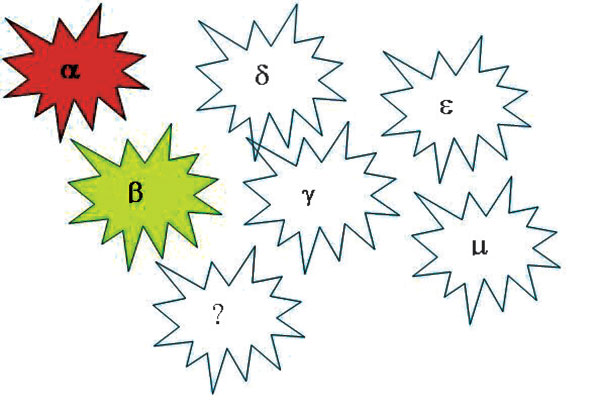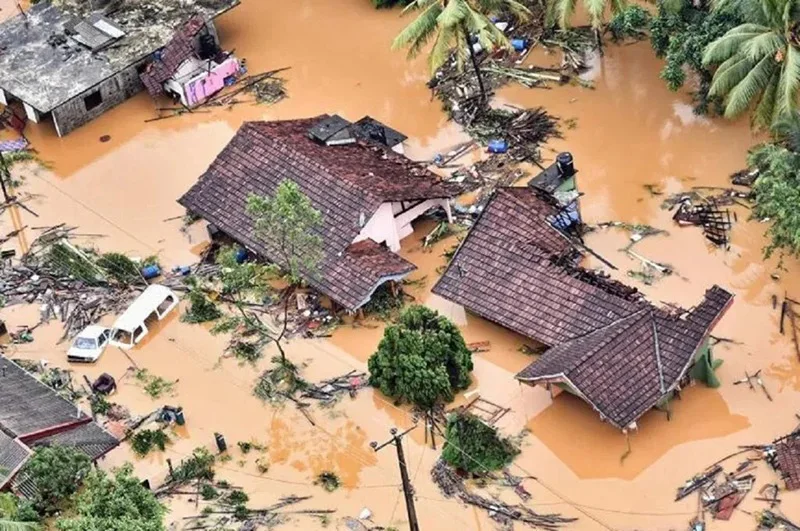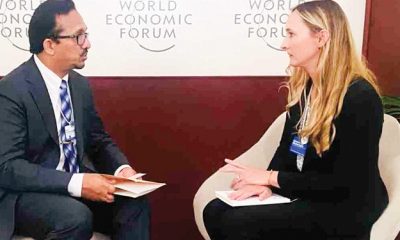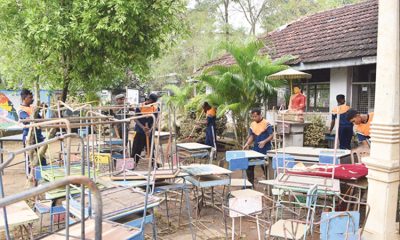Features
Pandemic and emergence of variants

By Prof Kirthi Tennakone
The behaviour of the coronavirus bears resemblance to a high-speed magnified video of Darwinian evolution. The virus changes in front of our eyes and variants emerge as the fittest that survive. Genome surveillance has succeeded in reading the genetic changes accurately and sees how the genotype expresses as phenotype. Genotype being the chemical-genetic constitution and phenotype, characters as manifested in the environmental background.
Humans have sinisterly arrested the natural evolution of animals and plants; but despite scientific advancements, find it difficult to deal with a fast-evolving virus, science alone cannot resolve a social calamity. Containment of the pandemic would be difficult if our actions lag in relation to the pace of virus evolution.
Mutations: cause of biological evolution
According to Charles Darwin’s theory of evolution, life on earth continues by descent, inheriting parental characters subject to infrequent variations or mutations. After the discovery of DNA, the mechanism of inheritance and mutations was understood.
The genetic material DNA, present in all living cells, is a double-stranded structure composed of bead-like moieties pairs, known as nucleotide bases, denoted by symbols A, T, G and C. The sequence of these entities in a strand encodes genetic information analogous to a four-letter alphabet. Some viruses contain one strand referred to as RNA and encode information in the same way. When the cell or the virus replicate, most of the time, the sequence of nucleotides is copied exactly giving birth to a genetically identical cell or a virus. Rarely, copying errors creep in during replication. For example, the sequence AAGCT may be miscopied as AAGCG. This is a minor change in comparison to the entire genome, nevertheless a genetic change or a mutation. Most mutations will not lead to overriding alterations in the character of an organism. Mutations are often deleterious. Very infrequently, a change in character, owing to a mutation, turns out to be beneficial for the species to survive and procreate.
Mutants fitting the environment survive and proliferate. Paleontological findings provide ample evidence of the evolutionary process, when noticeable changes in living species manifest during, more or less, millennia. In most cellular organisms a mutation, fit to get established, takes place once in a million generations. For that reason, we do not see sporadic changes in the progenies of animals and plants. In the past there had not been significant alterations in genetically transferred characters of wild animals. The leopards we see today are not different from ones that lived during the Anuradhapura period, their hunting capabilities are similar.
The situation is different if a virus invades a population devoid of immunity. Their intrinsically fast mutation and replication rates and sheer numbers, invariably bring forth more adaptable strains in very short periods. Certainly, the same phenomenon occurred during previous epidemics and pandemics. Today it is happening at an escalated level because of high human population density, mobility and unrestrained interference in the environment.
Viruses live on cellular life, constantly interacting and following their evolution, while they themselves evolve.
Unicellular and multicellular and viruses
The first living cells or unicellular microbes seemed to have originated 3.5 billion years ago. A giant step in the advancement of life on earth has been the appearance of multicellular organisms, living systems made of assemblies of cells. A mutation in a unicellular agent around 1.5 billion years ago is believed to have cleared the way for the development of multicellular life. These individual cells, sharing similar DNA, formed colonies. Later colonies subdivided, each expressing genetic instructions differently to create complex animals, with organs performing varying functions. The above developmental pathways, leading to advanced forms of life existing today, took more than one billion years.
Viruses are distinct from cellular forms of life. The latter possesses the capacity to grow and reproduce, deriving energy and essence of structural materials from non-living substances; whereas the former needs to enter a living cell to reproduce. All cellular creatures and viruses replicate, mutate and interact with each other and the external environment and evolve.
The pandemic is just one episode of this universal phenomenon, progressing fast and tracked by humans, the concern now is the threat posed by variants.
Variants of Coronavirus (SARS-CoV-2)
A variant means a mutated version of an organism, distinct from the original in a noticeable deviation of an observable trait. For example, king coconut is a variant of coconut, the distinguishing attribute being the colour of the nut. Apart from the shade of the nut, this particular mutation had turned the tree into a dwarf, very disadvantageous for harvesting sunlight. Unable to compete with other trees, the king coconut would not survive in the wild. Attracted by the colour, humans (in Sri Lanka) have taken care of the variety and propagated it.
In the case of the Coronavirus, the important qualities distinguishing variants are higher infectivity, degree of virulence and resistance to vaccines.
The Coronavirus and other RNA viruses mutate faster than DNA based organisms. Here the probability of a viable mutation per generation (replication) exceeds 10,000 times that of a cellular life form. Furthermore, the generation time of the Coronavirus is a few hours compared to years and months in the case of animals and the total population of viruses in bodies of infected persons, during the time of the pandemics, is many billions times larger than an animal population. Consequently, Coronavirus variants popped up in durations as short as a few months, after the aggravation of the pandemic in late 2020. The longer the pandemic lasts and the greater the intensity, the more variants we encounter.
Since the emergence of COVID-19 in Wuhan, China in December 2019 and its global spread, many variants have appeared in geographically distinct regions and crossed borders. The original version of the virus which triggered the epidemic in Wuhan underwent the mutation D614G altering the spike proteins, making it more contagious. Soon the strain D614G surfaced almost everywhere initiating the pandemic. It is the common ancestor of almost all variants seen today. The World Health Organization and Center for Disease Control, United States, have classified Coronavirus variants into three categories.
Variants of Concern
: They have increased transmissibility, detrimental alteration in epidemiology, enhanced virulence, decrease effectiveness in public health measures or available vaccines and diagnostics. The Alpha variant detected in the United Kingdom, September 2020; Beta in South Africa, May 2020; Gamma in Brazil November 2020; Delta in India October 2020 falls into this category.
Variants of Interest
: These are strains of the Coronavirus genetically distinguished by sequencing with potentialities of higher transmissibility, disease severity, and immunity resistance. They could pose threats in the future and need to be watched. Variants; Eta, Iota, Kappa, Lambda and Mu recently detected in Colombia are classified as variants of interest.
Variants of high consequence
: These are variants that would largely escape known control measures. Fortunately, at the moment, no candidates come under this category.
How Coronavirus variants originate
A variant begins as a mutation of one single virus in an infected person somewhere. It is very unlikely it would enter someone else and cause the disease. The variant requires to breed sufficiently in the individual in whom it was created. Again, in order to procreate and proliferate, it will have to compete with the parent strain, initially dominant in the patient. The variant will succeed in competing if it replicates faster and more effectively invades cells. As expected, all variants of concern possess the above qualities. Similarly, if the mutant had acquired the trait of evading host immunity, it could overshoot the parent strain.
Variants possibly originate and breed in immunosuppressed persons chronically infected with COVID-19. They carry large viral loads for prolonged durations, a pathology conducive to the birth and growth of variants. A wide range of mutants have been detected in such patients.
Characteristics of variants
Variants of concern spread faster in contrast to the parent strain. A pertinent question is, what changes in the virus provide this facility? For the virus to invade the human system, it must attach to a cell in the respiratory tract and transfer genetic material to the interior of the cell. The virus does this with a special protein in the spikes, binding selectively to a receptor in human cells named ACE2. In variants, the chemistry and architecture of the spikes are redesigned to enhance attachment. Thereafter, the migration of the replicating viruses to adjacent cells is also facilitated by the same process. The host antibodies drive the immune response by attacking spikes to suppress their bondage to the receptors. Mutagenic alterations in the spikes also help the variants to escape host immunity.
Most contagious Delta variant
The delta variant first identified in India, October 2020, resulted in an aggressive epidemic there and rapidly diffused. Several mutations in the spike proteins facilitated its fast spread. While retaining the common ancestral mutation D614G, the Delta carries three other mutations named P681R, L452R and D950N. The mutation D614G increases the number of spikes on the viral envelope. Production of higher viral loads in Delta-infected patients is believed to be a character manifested by the P681R mutation. Their respiratory tracts carry 1000 times more virus particles. The L452R mutation seems to protect spikes from antibodies helping immunity evasion. An ability of the Delta variant to attack a wider group of cells probably originates from a trait induced by D950N mutation. Mainly because of the changes in the spike proteins, the Delta variant reproduces faster by cell-to-cell invasion. Consequently, once this brand of Coronavirus enters a susceptible person, the symptoms appear in a shorter period of four to five days, compared to about a week for the alpha variant.
The Delta variant is 60 percent more transmissible than the alpha which stands 50 percent higher than the ancestral strain. A parameter defining the transmissibility of an infectious disease is the average number of cases reproduced by one carrier of the pathogen, the basic reproduction number (R0). An infection reaches epidemic proportions if R0 exceeds unity. When the pandemic originated in China, the value of R0 was about 2.5. The estimated value of R0 for the delta variant is somewhere between six and nine, an enormous increase in transmissibility relative to the previous strains.
Virus variants compete, whenever the Delta entered new territory, it out-competed other strains.
Vaccinations and Delta Variant
Except for a partial immunity evasion of the Delta variant, vaccines are effective against both variants. Vaccines lower the probability of catching the infection, more importantly greatly reduce serious complications and death. Some statistical assessments conclude that breakthrough infections (re-infections) are higher for the Delta variant compared to Alpha.
The discrepancies reported could also be indications of the fact that the Delta variant is far more contagious than previous strains. Here, the statistically meaningful epidemiological parameters are the number of different categories of infected persons (vaccinated, the severity of infection as determined by hospitalizations and mortality) as a percentage of the total number of infected individuals, recorded temporally. It is extremely difficult to keep track of these quantities when the disease spreads fast. Even the total number of people infected cannot be ascertained reliably. Under such circumstances, the anomalies reported as lesser effectiveness of vaccines in the case of the Delta variant, could also entail errors in data interpretation, arising from the fact that the Delta variant spreads fast.
There are also reports to the effect that more unvaccinated younger adults and children are hospitalized after the arrival of the Delta variant, reflecting the severity of symptoms. Theories have been put forward to explain the apparent anomaly. However, because of faster transmission of the Delta variant, proportionately younger patients may seek hospitalization.
As the dominant strain infecting a large proportion of people; the Delta variant will continue to mutate and evolve. Few mutational changes have already been noticed and named Delta pluses, but there is no evidence to conclude they are more dangerous.
Doomsday variant
News spreads like viruses. Just as mutations, inadvertent or deliberate distortions and exaggerations happen in reproducing news. Versions with more sensational twists disseminate faster.
In May 2021 a new variant carrying mutations suggestive of fast transmission and immunity resistance was identified in South Africa. Months later a reputed epidemiologist tweeted that the variant could be an imminent danger, prompting media to name it a doomsday variant. The ensuing panic was the result of premature unconfirmed assertion. The World Health Organization announced that this variant is not propagating as fast as the Delta.
Stories of pathogens spreading exceedingly fast, evading immunity, are common in science fiction. There is no evidence for such, even at times when preventive measures were completely unknown. Attributes encoded in different mutations do not add arithmetically. If one virus has a trait that allows it to spread fast and another to evade immunity, these two qualities will not necessarily be pronounced, to the same extent, in a third virus endowed with both mutations. Fear-mongering concerning doomsday viruses is most unlikely to persist.
Herd immunity and Delta variant
When the percentage of subjects acquiring immunity (either by vaccination or contracting the illness) exceeds a threshold, epidemics wane and disappear. The point at which this transpires depends on the value of the basic reproduction number R0; determined on the assumption there were no immune individuals, at the time the pathogen initiated the epidemic. As the immunity of the community increases, the reproduction number decreases proportionate to the fraction of people remaining susceptible and the rate of transmission is determined by an effective reproduction number RE. If N is the total population and M the number among them immune, the fraction susceptible is 1- M/N. Therefore the reproduction number reduces to the effective value RE = R0 (1 – M/N). Once RE reaches a value less than unity, the epidemic ceases to continue and the threshold corresponding to RE = 1, occurs when M/N = 1 -1/R0. At the beginning of the pandemic, the value of R0 was approximately 2.5 and the above formula yields M/N = 0.6, so that herd immunity threshold is 60 percent. For the highly transmissible Delta variant, a mean value of R0 is 7.5 and the same formula gives a herd immunity threshold of 87 percent. As vaccinated persons sometimes get re-infected, the actual threshold may exceed the above number, suggesting herd immunity is virtually beyond reach. Fortunately, R0 can be reduced by preventive measures such as social distancing, wearing masks and hand sanitization, thereby lowering the threshold.
Are we sufficiently disciplined to follow preventive measures stringently? The virus will continue to evolve via random mutations and their selection may be influenced by our behaviour. Will it turn more deadly or less deadly? These questions are too complex and unpredictable.
Fortunately, vaccines answer satisfactorily and redesigning and improvements are within reach. Preventive measures dampen transmission significantly. Every individual needs to follow these two strategies confidently, without resorting to unproven practices and myth.
Features
Trade preferences to support post-Ditwah reconstruction

The manner in which the government succeeded in mobilising support from the international community, immediately after the devastating impact of Cyclone Ditwah, may have surprised many people of this country, particularly because our Opposition politicians were ridiculing our “inexperienced” government, in the recent past, for its inability to deal with the international community effectively. However, by now it is evident that the government, with the assistance of the international community and local nongovernmental actors, like major media organisations, has successfully managed the recovery efforts. So, let me begin by thanking them for what they have done so far.
Yet, some may argue that it is not difficult to mobilise the support for recovery efforts from the international community, immediately after any major disaster, and the real challenge is to sustain that support through the next few weeks, months and years. Because the recovery process, more specifically the post-recovery reconstruction process, requires long-term support. So, the government agencies should start immediately to focus on, in addition to initial disaster relief, a longer-term strategy for reconstruction. This is important because in a few weeks’ time, the focus of the global community may shift elsewhere … to another crisis in another corner of the world. Before that happens, the government should take initiatives to get the support from development partners on appropriate policy measures, including exceptional trade preferences, to help Sri Lanka in the recovery efforts through the medium and the long term.
Use of Trade Preferences to support recovery and reconstruction
In the past, the United States and the European Union used exceptional enhanced trade preferences as part of the assistance packages when countries were devastated by natural disasters, similar to Cyclone Ditwah. For example:
- After the devastating floods in Pakistan, in July 2010, the EU granted temporary, exceptional trade preferences to Pakistan (autonomous trade preferences) to aid economic recovery. This measure was a de facto waiver on the standard EU GSP (Generalised Scheme of Preferences) rules. The preferences, which were proposed in October 2010 and were applied until the end of 2013, effectively suspended import duties on 75 types of goods, including textiles and apparel items. The available studies on this waiver indicate that though a significant export hike occurred within a few months after the waiver became effective it did not significantly depress exports by competing countries. Subsequently, Pakistan was granted GSP+ status in 2014.
- Similarly, after the 2015 earthquakes in Nepal, the United States supported Nepal through an extension of unilateral additional preferences, the Nepal Trade Preferences Programme (NTPP). This was a 10-year initiative to grant duty-free access for up to 77 specific Nepali products to aid economic recovery after the 2015 earthquakes. This was also a de facto waiver on the standard US GSP rules.
- Earlier, after Hurricanes Mitch and Georges caused massive devastation across the Caribbean Basin nations, in 1998, severely impacting their economies, the United States proposed a long-term strategy for rebuilding the region that focused on trade enhancement. This resulted in the establishment of the US Caribbean Basin Trade Partnership Act (CBTPA), which was signed into law on 05 October, 2000, as Title II of the Trade and Development Act of 2000. This was a more comprehensive facility than those which were granted to Pakistan and Nepal.

What type of concession should Sri Lanka request from our development partners?
Given these precedents, it is appropriate for Sri Lanka to seek specific trade concessions from the European Union and the United States.
In the European Union, Sri Lanka already benefits from the GSP+ scheme. Under this arrangement Sri Lanka’s exports (theoretically) receive duty-free access into the EU markets. However, in 2023, Sri Lanka’s preference utilisation rate, that is, the ratio of preferential imports to GSP+ eligible imports, stood at 59%. This was significantly below the average utilisation of other GSP beneficiary countries. For example, in 2023, preference utilisation rates for Bangladesh and Pakistan were 90% and 88%, respectively. The main reason for the low utilisation rate of GSP by Sri Lanka is the very strict Rules of Origin requirements for the apparel exports from Sri Lanka. For example, to get GSP benefits, a woven garment from Sri Lanka must be made from fabric that itself had undergone a transformation from yarn to fabric in Sri Lanka or in another qualifying country. However, a similar garment from Bangladesh only requires a single-stage processing (that is, fabric to garment) qualifies for GSP. As a result, less than half of Sri Lanka’s apparel exports to the EU were ineligible for the preferences in 2023.
Sri Lanka should request a relaxation of this strict rule of origin to help economic recovery. As such a concession only covers GSP Rules of Origin only it would impact multilateral trade rules and would not require WTO approval. Hence could be granted immediately by the EU.
United States
Sri Lanka should submit a request to the United States for (a) temporary suspension of the recently introduced 20% additional ad valorem duty and (b) for a programme similar to the Nepal Trade Preferences Programme (NTPP), but designed specifically for Sri Lanka’s needs. As NTPP didn’t require WTO approval, similar concessions also can be granted without difficulty.
Similarly, country-specific requests should be carefully designed and submitted to Japan and other major trading partners.
(The writer is a retired public servant and can be reached at senadhiragomi@gmail.com)
by Gomi Senadhira
Features
Lasting power and beauty of words

Novelists, poets, short story writers, lyricists, politicians and columnists use words for different purposes. While some of them use words to inform and elevate us, others use them to bolster their ego. If there was no such thing called words, we cannot even imagine what will happen to us. Whether you like it or not everything rests on words. If the Penal Code does not define a crime and prescribe a punishment, judges will not be able to convict criminals. Even the Constitution of our country is a printed document.
A mother’s lullaby contains snatches of sweet and healing words. The effect is immediate. The baby falls asleep within seconds. A lover’s soft and alluring words go right into his or her beloved. An army commander’s words encourage soldiers to go forward without fear. The British wartime Prime Minister Winston Churchill’s words still ring in our ears: “… we shall defend our Island, whatever the cost may be, we shall fight on the beaches, we shall fight on the landing grounds, we shall fight in the fields and in the streets, we shall fight in the hills; we shall never surrender …”
Writers wax eloquent on love. English novelist John Galsworthy wrote: “Love is no hot-house flower, but a wild plant, born of a wet night, born of an hour of sunshine; sprung from wild seed, blown along the road by a wild wind. A wild plant that, when it blooms by chance within the hedge of our gardens, we call a flower; and when it blooms outside we call a weed; but flower or weed, whose scent and colour are always wild.” While living in a world dominated by technology, we often hear a bunch of words that is colourless and often cut to verbal ribbons – “How R U” or “Luv U.” Such words seem to squeeze the life out of language.
Changing medium
Language is a constantly changing medium. New words and forms arrive and old ones die out. Whoever thought that the following Sinhala words would find a place in the Oxford English Dictionary? “Asweddumize, Avurudu, Baila, Kiribath, Kottu Roti, Mallung, Osari, Papare, Walawwa and Watalappan.” With all such borrowed words the English language is expanding and remains beautiful. The language helps us to express subtle ideas clearly and convincingly.
You are judged by the words you use. If you constantly use meaningless little phrases, you will be considered a worthless person. When you read a well-written piece of writing you will note how words jump and laugh on the paper or screen. Some of them wag their tails while others stand back like shy village belles. However, they serve a useful purpose. Words help us to write essays, poems, short stories and novels. If not for the beauty of the language, nobody will read what you write.
If you look at the words meaningfully, you will see some of them tap dancing while others stand to rigid attention. Big or small, all the words you pen form part of the action or part of the narrative. The words you write make your writing readable and exciting. That is why we read our favourite authors again and again.
Editorials
If a marriage is to succeed, partners should respect and love each other. Similarly, if you love words, they will help you to use them intelligently and forcefully. A recent survey in the United States has revealed that only eight per cent of people read the editorial. This is because most editorials are not readable. However, there are some editorials which compel us to read them. Some readers collect such editorials to be read later.
Only a lover of words would notice how some words run smoothly without making a noise. Other words appear to be dancing on the floor. Some words of certain writers are soothing while others set your blood pounding. There is a young monk who is preaching using simple words very effectively. He has a large following of young people addicted to drugs. After listening to his preaching, most of them have given up using illegal drugs. The message is loud and clear. If there is no demand for drugs, nobody will smuggle them into the country.
Some politicians use words so rounded at the edges and softened by wear that they are no longer interesting. The sounds they make are meaningless and listeners get more and more confused. Their expressions are full of expletives the meaning of which is often soiled with careless use of words.
Weather-making
Some words, whether written or spoken, stick like superglue. You will never forget them. William Vergara in his short essay on weather-making says, “Cloud-seeding has touched off one of the most baffling controversies in meteorological history. It has been blamed for or credited with practically all kinds of weather. Some scientists claim seeding can produce floods and hail. Others insist it creates droughts and dissipates clouds. Still others staunchly maintain it has no effect at all. The battle is far from over, but at last one clear conclusion is beginning to emerge: man can change the weather, and he is getting better at it.”
There are words that nurse the ego and heal the heart. The following short paragraph is a good example. S. Radhakrishnan says, “In every religion today we have small minorities who see beyond the horizon of their particular faith, not through religious fellowship is possible, not through the imposition of any one way on the whole but through an all-inclusive recognition that we are all searchers for the truth, pilgrims on the road, that we all aim at the same ethical and spiritual standard.”
There are some words joined together in common phrases. They are so beautiful that they elevate the human race. In the phrase ‘beyond a shadow of doubt’, ‘a shadow’ connotes a dark area covering light. ‘A doubt’ refers to hesitancy in belief. We use such phrases blithely because they are exquisitely beautiful in their structure. The English language is a repository of such miracles of expression that lead to deeper understanding or emphasis.
Social media
Social media use words powerfully. Sometimes they invent new words. Through the social media you can reach millions of viewers without the intervention of the government. Their opinion can stop wars and destroy tyrants. If you use the right words, you can even eliminate poverty to a great extent.
The choice of using powerful words is yours. However, before opening your mouth, tap the computer, unclip a pen, write a lyric or poem, think twice of the effect of your writing. When you talk with a purpose or write with pleasure, you enrich listeners and readers with your marvellous language skills. If you have a command of the language, you will put across your point of view that counts. Always try to find the right words and change the world for a better place for us to live.
By R. S. Karunaratne
karunaratners@gmail.com
Features
Why Sri Lanka Still Has No Doppler Radar – and Who Should Be Held Accountable

Eighteen Years of Delay:
Cyclone Ditwah has come and gone, leaving a trail of extensive damage to the country’s infrastructure, including buildings, roads, bridges, and 70% of the railway network. Thousands of hectares of farming land have been destroyed. Last but not least, nearly 1,000 people have lost their lives, and more than two million people have been displaced. The visuals uploaded to social media platforms graphically convey the widespread destruction Cyclone Ditwah has caused in our country.
The purpose of my article is to highlight, for the benefit of readers and the general public, how a project to establish a Doppler Weather Radar system, conceived in 2007, remains incomplete after 18 years. Despite multiple governments, shifting national priorities, and repeated natural disasters, the project remains incomplete.
Over the years, the National Audit Office, the Committee on Public Accounts (COPA), and several print and electronic media outlets have highlighted this failure. The last was an excellent five-minute broadcast by Maharaja Television Network on their News First broadcast in October 2024 under a series “What Happened to Sri Lanka”
The Agreement Between the Government of Sri Lanka and the World Meteorological Organisation in 2007.
The first formal attempt to establish a Doppler Radar system dates back to a Trust Fund agreement signed on 24 May 2007 between the Government of Sri Lanka (GoSL) and the World Meteorological Organisation (WMO). This agreement intended to modernize Sri Lanka’s meteorological infrastructure and bring the country on par with global early-warning standards.
The World Meteorological Organisation (WMO) is a specialized agency of the United Nations established on March 23, 1950. There are 193 member countries of the WMO, including Sri Lanka. Its primary role is to promote the establishment of a worldwide meteorological observation system and to serve as the authoritative voice on the state and behaviour of the Earth’s atmosphere, its interaction with the oceans, and the resulting climate and water resources.
According to the 2018 Performance Audit Report compiled by the National Audit Office, the GoSL entered into a trust fund agreement with the WMO to install a Doppler Radar System. The report states that USD 2,884,274 was deposited into the WMO bank account in Geneva, from which the Department of Metrology received USD 95,108 and an additional USD 113,046 in deposit interest. There is no mention as to who actually provided the funds. Based on available information, WMO does not fund projects of this magnitude.
The WMO was responsible for procuring the radar equipment, which it awarded on 18th June 2009 to an American company for USD 1,681,017. According to the audit report, a copy of the purchase contract was not available.
Monitoring the agreement’s implementation was assigned to the Ministry of Disaster Management, a signatory to the trust fund agreement. The audit report details the members of the steering committee appointed by designation to oversee the project. It consisted of personnel from the Ministry of Disaster Management, the Departments of Metrology, National Budget, External Resources and the Disaster Management Centre.
The Audit Report highlights failures in the core responsibilities that can be summarized as follows:
· Procurement irregularities—including flawed tender processes and inadequate technical evaluations.
· Poor site selection
—proposed radar sites did not meet elevation or clearance requirements.
· Civil works delays
—towers were incomplete or structurally unsuitable.
· Equipment left unused
—in some cases for years, exposing sensitive components to deterioration.
· Lack of inter-agency coordination
—between the Meteorology Department, Disaster Management Centre, and line ministries.
Some of the mistakes highlighted are incomprehensible. There is a mention that no soil test was carried out before the commencement of the construction of the tower. This led to construction halting after poor soil conditions were identified, requiring a shift of 10 to 15 meters from the original site. This resulted in further delays and cost overruns.
The equipment supplier had identified that construction work undertaken by a local contractor was not of acceptable quality for housing sensitive electronic equipment. No action had been taken to rectify these deficiencies. The audit report states, “It was observed that the delay in constructing the tower and the lack of proper quality were one of the main reasons for the failure of the project”.
In October 2012, when the supplier commenced installation, the work was soon abandoned after the vehicle carrying the heavy crane required to lift the radar equipment crashed down the mountain. The next attempt was made in October 2013, one year later. Although the equipment was installed, the system could not be operationalised because electronic connectivity was not provided (as stated in the audit report).
In 2015, following a UNOPS (United Nations Office for Project Services) inspection, it was determined that the equipment needed to be returned to the supplier because some sensitive electronic devices had been damaged due to long-term disuse, and a further 1.5 years had elapsed by 2017, when the equipment was finally returned to the supplier. In March 2018, the estimated repair cost was USD 1,095,935, which was deemed excessive, and the project was abandoned.
COPA proceedings
The Committee on Public Accounts (COPA) discussed the radar project on August 10, 2023, and several press reports state that the GOSL incurred a loss of Rs. 78 million due to the project’s failure. This, I believe, is the cost of constructing the Tower. It is mentioned that Rs. 402 million had been spent on the radar system, of which Rs. 323 million was drawn from the trust fund established with WMO. It was also highlighted that approximately Rs. 8 million worth of equipment had been stolen and that the Police and the Bribery and Corruption Commission were investigating the matter.
JICA support and project stagnation
Despite the project’s failure with WMO, the Japan International Cooperation Agency (JICA) entered into an agreement with GOSL on June 30, 2017 to install two Doppler Radar Systems in Puttalam and Pottuvil. JICA has pledged 2.5 billion Japanese yen (LKR 3.4 billion at the time) as a grant. It was envisaged that the project would be completed in 2021.
Once again, the perennial delays that afflict the GOSL and bureaucracy have resulted in the groundbreaking ceremony being held only in December 2024. The delay is attributed to the COVID-19 pandemic and Sri Lanka’s economic crisis.
The seven-year delay between the signing of the agreement and project commencement has led to significant cost increases, forcing JICA to limit the project to installing only one Doppler Radar system in Puttalam.
Impact of the missing radar during Ditwah
As I am not a meteorologist and do not wish to make a judgment on this, I have decided to include the statement issued by JICA after the groundbreaking ceremony on December 24, 2024.
“In partnership with the Department of Meteorology (DoM), JICA is spearheading the establishment of the Doppler Weather Radar Network in the Puttalam district, which can realize accurate weather observation and weather prediction based on the collected data by the radar. This initiative is a significant step in strengthening Sri Lanka’s improving its climate resilience including not only reducing risks of floods, landslides, and drought but also agriculture and fishery“.
Based on online research, a Doppler Weather Radar system is designed to observe weather systems in real time. While the technical details are complex, the system essentially provides localized, uptotheminute information on rainfall patterns, storm movements, and approaching severe weather. Countries worldwide rely on such systems to issue timely alerts for monsoons, tropical depressions, and cyclones. It is reported that India has invested in 30 Doppler radar systems, which have helped minimize the loss of life.
Without radar, Sri Lanka must rely primarily on satellite imagery and foreign meteorological centres, which cannot capture the finescale, rapidly changing weather patterns that often cause localized disasters here.
The general consensus is that, while no single system can prevent natural disasters, an operational Doppler Radar almost certainly would have strengthened Sri Lanka’s preparedness and reduced the extent of damage and loss.
Conclusion
Sri Lanka’s inability to commission a Doppler Radar system, despite nearly two decades of attempts, represents one of the most significant governance failures in the country’s disastermanagement history.
Audit findings, parliamentary oversight proceedings, and donor records all confirm the same troubling truth: Sri Lanka has spent public money, signed international agreements, received foreign assistance, and still has no operational radar. This raises a critical question: should those responsible for this prolonged failure be held legally accountable?
Now may not be the time to determine the extent to which the current government and bureaucrats failed the people. I believe an independent commission comprising foreign experts in disaster management from India and Japan should be appointed, maybe in six months, to identify failures in managing Cyclone Ditwah.
However, those who governed the country from 2007 to 2024 should be held accountable for their failures, and legal action should be pursued against the politicians and bureaucrats responsible for disaster management for their failure to implement the 2007 project with the WMO successfully.
Sri Lanka cannot afford another 18 years of delay. The time for action, transparency, and responsibility has arrived.
(The views and opinions expressed in this article are solely those of the author and do not necessarily reflect the policy or position of any organization or institution with which the author is affiliated).
By Sanjeewa Jayaweera
-

 Features6 days ago
Features6 days agoFinally, Mahinda Yapa sets the record straight
-

 News7 days ago
News7 days agoCyclone Ditwah leaves Sri Lanka’s biodiversity in ruins: Top scientist warns of unseen ecological disaster
-

 Features6 days ago
Features6 days agoHandunnetti and Colonial Shackles of English in Sri Lanka
-

 Business4 days ago
Business4 days agoCabinet approves establishment of two 50 MW wind power stations in Mullikulum, Mannar region
-

 News5 days ago
News5 days agoGota ordered to give court evidence of life threats
-

 Features7 days ago
Features7 days agoAn awakening: Revisiting education policy after Cyclone Ditwah
-

 Features5 days ago
Features5 days agoCliff and Hank recreate golden era of ‘The Young Ones’
-

 Opinion6 days ago
Opinion6 days agoA national post-cyclone reflection period?













